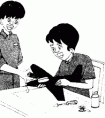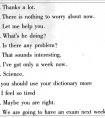I’ll remember the first carnival(狂欢节). 小题1:. My parents came from Jamaica and they helped to start carnival. We had very little money, but we made costu-九年级英语
题文
| I’ll remember the first carnival(狂欢节). 小题1:. My parents came from Jamaica and they helped to start carnival. We had very little money, but we made costumers from old bits of material and feathers, and colourful masks. We decorated old lorries, so that we could ride on them through the streets. It took us six months to get ready. But on the big day, all our hard work had been worth it. People of all ages, from babies to grandparents, black and white, danced together in the street. 小题2:. The music was played on anything made of metal: it was very noisy. There were people watching from the windows of every house. We ate all our favourite Jamaican food, washed down with beer.小题3:– but carnival helps you forget the weather! When the carnival got too big, those old streets became too narrow for such big crowds(人群). Some people said they felt frightened by the large crowds and the noise. We were worried that carnival would be banned(禁止). Then we found an answer – everything was moved to a wider and safer street. 小题4:.
|
答案
小题1:A 小题2:C 小题3:B 小题4:E |
小题1:从第一句话:I’ll remember the first carnival(狂欢节). 可知选A,是开始于20世纪60年代。 小题2:从前面的句子:People of all ages, from babies to grandparents, black and white, danced together in the street.可知警察也跳舞。选C 小题3:从后面句子:but carnival helps you forget the weather!可知是讲天气。选 B 小题4:从前面的句子:everything was moved to a wider and safer street.可知狂欢节可以持续好几年。选E |
据专家权威分析,试题“I’ll remember the first carnival(狂欢节). 小题1:. My pare..”主要考查你对 情景交际,日常用语、谚语 等考点的理解。关于这些考点的“档案”如下:
情景交际日常用语、谚语
考点名称:情景交际
- 情景交际:
也叫口语应用,试题根据对话的基本形式是一问一答的特点,通过提供一定的语境,将语言放在交际的实际情景中去考查。
它所涉及的内容多是初中英语课本中出现过的与学生学习、生活相联系、实用性强的内容。
它既考查特定交际场合使用的表达方式,也通过语境考查词汇和语法知识的运用。 - 情景交际题注意事项:
1.所补全的对话内容必须能使上、下文连贯一致,因而必须瞻前顾后、全盘考虑,不能仅看上一个问句就选择答句,或仅根据下文中的答句就补全它的问句,否则容易造成逻辑错误。
2. 做题前应注意试题前面是否有中文或英语的背景提示。这些背景提示是确定话题内容的重要依据,不可疏忽带过。
3. 在选择过程中考生应注意把已选出的选项划去,避免重复选择的错误。
4. 做题时要先易后难,一时难以确定不要勉强先做,否则易造成连锁错误。 - 解题思路与技巧:
1. 通览全文,领会大意,揣摩话题。解题时应先跳过空格通览全文,了解对话大意,根据对大意的把握,判定语境,揣摩话题。
2. 根据语境,细读选项,选择答案。在把握话题和语境的基础上,针对对话的每一空白处,细读所提供的选项,认真分析它们之间的异同,依据对话有关情景内容,选择正确的答案。
3.通盘考虑,前后联想,先易后难。要从对话整体理解出发,依照上、下问答的逻辑顺序来考虑所选择的答案,不可不顾前后顺序,孤立地就上句就补下句,这样可能出现所补句子符合上文而不符合下文的情况。要先解决有把握的、容易的,再回头补选较难的。
4.通读对话,义形结合,验证答案。将对话补全之后,再将整段对话通读一遍,逐一验证答案。所选的答案不仅语义上要符合语境,而且要保证语言正确,做到说话得体。
考点名称:日常用语、谚语
- 日常用语:
就是日常生活中的交际用语,如Thank you. Sorry.等
谚语:
即是人们生活中常用的现成的话。
谚语类似成语,但口语性强,通俗易懂,而且一般都表达一个完整的意思,形式上差不多都是一两个短句。
例如:Helaughsbestwholaughslast.谁笑到最后,谁就笑得最好。
Nopains,nogains.没有付出,就没有收获。 英语日常交际用语分类:
打招呼与告别用语(Greeting and Saying Good-bye)
1.-How are you ?
-I’m fine, thanks.
2. -Nice to meet you.
-Nice to meet you, too.谈论颜色(Talking about colour)
1. -What colour is it?
-It’s red.
2. -What’s you favourite colour, Jenny?
-My favourite colour is blue.
3. -How many colours do you like?
-Three.谈论高度(Talking about height)
1. -Are you short or tall?
-I’m short/tall.
2. -How tall am I, Mr Wood?
-You’re 1.6 metres tall.看病用语(Seeing a doctor)
1. -What’s the matter?
-I cut my knee. It hurts.就餐用语(Having meals)
1. -Would you like some dumpling?
-No, thanks./ Yes please.
2. I’d like porridge for breakfast.
3. It’s /Thery’re delicious.
4. What would you like for supper?
5. -Are you ready to order?
-Yes, please. I’d like…….谈论天气(Talking about weather)
1 -How is the weather today?/ What’s the weather like today?
-It’ sunny rainy snowy windy.
2. -Is it snowy?
- No , it’s hot today.
3. -what’s the temperature?
- 最新内容
- 相关内容
- 网友推荐
- 图文推荐
| [家长教育] 孩子为什么会和父母感情疏离? (2019-07-14) |
| [教师分享] 给远方姐姐的一封信 (2018-11-07) |
| [教师分享] 伸缩门 (2018-11-07) |
| [教师分享] 回家乡 (2018-11-07) |
| [教师分享] 是风味也是人间 (2018-11-07) |
| [教师分享] 一句格言的启示 (2018-11-07) |
| [教师分享] 无规矩不成方圆 (2018-11-07) |
| [教师分享] 第十届全国教育名家论坛有感(二) (2018-11-07) |
| [教师分享] 贪玩的小狗 (2018-11-07) |
| [教师分享] 未命名文章 (2018-11-07) |






